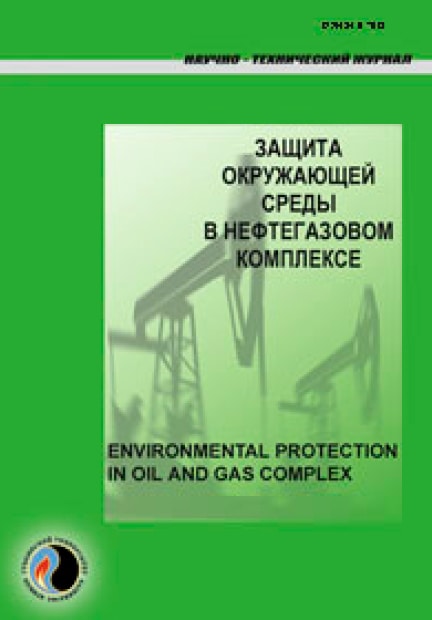Scientific and technical journal
«Environmental protection in oil and gas complex»
ISSN 2411-7013

Environmentally friendly alternative: using biosurfactants for cleaning oil-contaminated soils
UDC: 504.06:677.042.23
DOI: -
Authors:
1 National University of Oil and Gas "Gubkin University", Moscow, Russia
Keywords: biosurfactants, rhamnolipids, oil-contaminated soils, washing, environmentally friendly cleaning, biodegradability, bioavailability, low toxicity
Annotation:
The authors of the article present research on the characterization and application of biosurfactants for washing oil-contaminated soils. The effectiveness of various types of biosurfactants used for washing oil-contaminated soils is analyzed. The advantages and disadvantages of biosurfactants compared to synthetic surfactants are discussed. It is shown that the use of biosurfactants is an effective and environmentally clean alternative method of oil-contaminated soils remediation. The potential for using biosurfactants in addressing soil oil contamination problems is highlighted.
Bibliography:
1. Solyanikova I.P., Golovleva L.A. Geksadekan i bakterii-destruktory: mekhanizmy vzaimodeystviya // Mikrobiologiya. – 2019. – T. 88, № 1. – S. 19–31. – DOI: 10.1134/S00263656180601622. Tsyplyuk V.A. Sovremennoe primenenie biosurfaktantov v meditsine // Vestn. PNIPU. Khimicheskaya tekhnologiya i biotekhnologiya. – 2022. – № 3. – S. 31–46. – DOI: 10.15593/2224-9400/2022.2.03
3. Microbial Biosurfactants: An Overview of their Uses, Classification, Types, Properties, and Biosynthesis / P. Priyanshi, P. Hetshree, S. Janvi [et al.] // Acta Scientific Microbiology. – 2023. – Vol. 6, Issue 6. – P. 61–71. – DOI: 10.31080/ASMI.2023.06.1260
4. Guzmán E., Ortega F., Rubio R.G. Exploring the World of Rhamnolipids: A critical review of their production, interfacial properties, and potential application // Current Opinion in Colloid & Interface Science. – 2024. – Vol. 69. – P. 101780. – DOI: 10.1016/j.cocis.2023.101780
5. Use of surfactants for the remediation of contaminated soils: A review / Mao Xuhui, Jiang Rui, Xiao Wei, Yu Jiaguo // J. of Hazardous Materials. – 2014. – Vol. 285. – P. 419–435. – DOI: 10.1016/j.jhazmat.2014.12.009
6. Stabilizatsiya emul'siy nefti v vode vysokodispersnymi chastitsami: rol' v protsessakh samoochishcheniya i perspektivy prakticheskogo primeneniya / N.Yu. Grechishcheva, I.V. Perminova, V.A. Kholodov, S.V. Meshcheryakov // Rossiyskiy khimicheskiy zhurn. – 2015. – T. 59, № 4. – S. 34–50.
7. Plotnikova M.D., Shcherban' M.G., Medvedeva N.A. Perspektivy ispol'zovaniya vodnykh kompozitsiy poverkhnostno-aktivnykh veshchestv dlya ochistki neftezagryaznennykh gruntov // Geograficheskiy vestn. – 2016. – № 3(38). – S. 114–121. – DOI: 10.17072/2079-7877-2016-3-114-121
8. Advances in applications of rhamnolipids biosurfactant in environmental remediation: A review / Liu Guansheng, Zhong Hua, Yang Xin [et al.] // Biotechnology and Bioengineering. – 2017. – Vol. 115, Issue 4. – P. 796–814. – DOI: 10.1002/bit.26517
9. Application of Green Surfactants in the Remediation of Soils Contaminated by Hydrocarbons / I.G.S. da Silva, F.C.G. de Almeida, N.M.P. da Rocha e Silva [et al.] // Processes. – 2021. – Vol. 9, Issue 9. – P. 1666. – DOI: 10.3390/pr9091666
10. Biosurfactants production using glucose and molasses as carbon sources by Azotobacter vinelandii and soil washing application in hydrocarbon-contaminated soil / L.A. Devianto, C.E.L. Latunussa, Q. Helmy, E. Kardena // IOP Conference Series: Earth and Environmental Science. Vol. 475. Int. Conf. on Green Agroindustry and Bioeconomy, Malang, East Java, Aug. 26–27, 2019. – IOP Publishing, 2020. – P. 012075. – DOI: 10.1088/1755-1315/475/1/012075
11. Singh A.K., Cameotra S.S. Efficiency of lipopeptide biosurfactants in removal of petroleum hydrocarbons and heavy metals from contaminated soil // Environmental Science and Pollution Research. – 2013. – Vol. 20. – P. 7367–7376. – DOI: 10.1007/s11356-013-1752-4
12. Durval I., Rufino R., Sarubbo L. Biosurfactant as an Environmental Remediation Agent: Toxicity, Formulation, and Application in the Removal of Petroderivate in Sand and Rock Walls // Biointerface Research in Applied Chemistry. – 2022. – Vol. 12, Issue 1. – P. 34–48. – DOI: 10.33263/BRIAC121.034048
13. Insights into rhamnolipid-based soil remediation technologies by safe microorganisms: A critical review / A. Chebbi, A. Franzetti, F. Formicola [et al.] // J. of Cleaner Production. – 2022. – Vol. 367. – P. 133088. – DOI: 10.1016/j.jclepro.2022.133088
14. Olasanmi I.O., Thring R.W. Evaluating Rhamnolipid-Enhanced Washing as a First Step in Remediation of Drill Cuttings and Petroleum-Contaminated Soils // J. of Advanced Research. – 2020. – Vol. 21. – P. 79–90. – DOI: 10.1016/j.jare.2019.07.003
15. Biosurfactant-enhanced removal of total petroleum hydrocarbons from contaminated soil / Lai Chin-Chi, Huang Yi-Chien, Wei Yu-Hong, Chang Jo-Shu // J. of Hazardous Materials. – 2009. – Vol. 167, Issues 1–3. – P. 609–614. – DOI: 10.1016/j.jhazmat.2009.01.017
16. Biosurfactant Production from Candida Guilliermondii and Evaluation of Its Toxicity / I.R.A. da S. Lira, E.M. da S. Santosa, A.A.P. Selva Filho [et al.] // Chemical Engineering Transactions. – 2020. – Vol. 79. – P. 457–462. – DOI: 10.3303/CET2079077
17. Preparation, characterization and application of biosurfactant in various industries: A critical review on progress, challenges and perspectives / T.G. Ambaye, M. Vaccari, S. Prasad, S. Rtimi // Environmental Technology & Innovation. – 2021. – Vol. 24. – P. 102090. – DOI: 10.1016/j.eti.2021.102090
18. Fernandes N., Simões L., Dias D. Biosurfactants Produced by Yeasts: Fermentation, Screening, Recovery, Purification, Characterization, and Applications // Fermentation. – 2023. – Vol. 9, Issue 3. – P. 207. – DOI: 10.3390/fermentation9030207
19. Starodubtseva K.A., Zavorotnyy V.L., Grechishcheva N.Yu. Issledovanie zakonomernostey poverkhnostno-aktivnykh i ekotoksikologicheskikh svoystv aminoamidov oleinovoy kisloty // Zashchita okruzhayushchey sredy v neftegazovom komplekse. – 2023. – № 1(310). – S. 5–12. – DOI: 10.33285/2411-7013-2023-1(310)-5-12